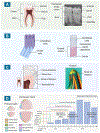Teeth as Potential New Tools to Measure Early-Life Adversity and Subsequent Mental Health Risk: An Interdisciplinary Review and Conceptual Model
- PMID: 31858984
- PMCID: PMC7822497
- DOI: 10.1016/j.biopsych.2019.09.030
Teeth as Potential New Tools to Measure Early-Life Adversity and Subsequent Mental Health Risk: An Interdisciplinary Review and Conceptual Model
Abstract
Early-life adversity affects nearly half of all youths in the United States and is a known risk factor for psychiatric disorders across the life course. One strategy to prevent mental illness may be to target interventions toward children who are exposed to adversity, particularly during sensitive periods when these adversities may have even more enduring effects. However, a major obstacle impeding progress in this area is the lack of tools to reliably and validly measure the existence and timing of early-life adversity. In this review, we summarize empirical work across dentistry, anthropology, and archaeology on human tooth development and discuss how teeth preserve a time-resolved record of our life experiences. Specifically, we articulate how teeth have been examined in these fields as biological fossils in which the history of an individual's early-life experiences is permanently imprinted; this area of research is related to, but distinct from, studies of oral health. We then integrate these insights with knowledge about the role of psychosocial adversity in shaping psychopathology risk to present a working conceptual model, which proposes that teeth may be an understudied yet suggestive new tool to identify individuals at risk for mental health problems following early-life psychosocial stress exposure. We end by presenting a research agenda and discussion of future directions for rigorously testing this possibility and with a call to action for interdisciplinary research to meet the urgent need for new biomarkers of adversity and psychiatric outcomes.
Keywords: Adversity; Biomarkers; Mental health; Prevention; Stress; Teeth.
Copyright © 2019 Society of Biological Psychiatry. Published by Elsevier Inc. All rights reserved.
Conflict of interest statement
The authors report no biomedical financial interests or potential conflicts of interest.
Figures


References
-
- Sacks V, Murphy D (2018): The prevalence of adverse childhood experiences, nationally, by state, and by race or ethnicity. Available at: https://www.childtrends.org/publications/prevalence-adverse-childhood-ex.... Accessed October 15, 2018.
Publication types
MeSH terms
Grants and funding
LinkOut - more resources
Full Text Sources
Medical
Miscellaneous

